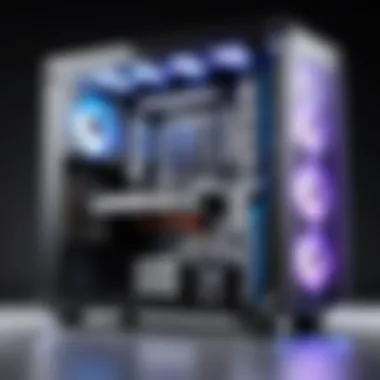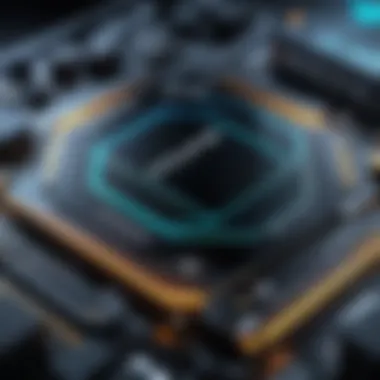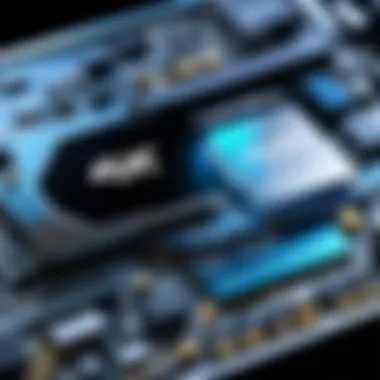Maximize Your Game Performance: Essential Strategies


Intro
In the realm of gaming, performance is paramount. As technology evolves, players demand not only graphic fidelity but also responsive and smooth gameplay. This guide aims to explore techniques that help optimize both software and hardware, ensuring that gamers have the best possible experience. The strategies discussed herein are designed to help players tackle common performance issues, educate them on resource management, and ultimately refine their gaming setups.
Overview of the Technology
Understanding the underlying technology can significantly impact gaming performance. Various components work in unison to deliver seamless gameplay. Here, we focus on critical specifications and unique selling points that enhance performance.
Key Specifications
- Processor (CPU): A powerful CPU is essential for handling complex computations. Modern gaming often relies on multi-core processors, such as AMD Ryzen 5000 series and Intel Core i9.
- Graphics Card (GPU): The GPU is crucial for rendering graphics. High-end options like NVIDIA GeForce RTX 30 series or AMD Radeon RX 6000 series deliver exceptional visual experiences.
- RAM: Sufficient RAM allows for smooth multitasking and is vital to reducing lag when running multiple applications. Generally, 16GB is a good standard for most games.
- Storage: Solid-State Drives (SSDs) offer faster load times compared to traditional Hard Disk Drives (HDDs), which significantly improves game launch and transition times.
Unique Selling Points
- Customizability: Many modern consoles and PCs allow for extensive customization, from hardware to software tweaks.
- Performance Monitoring: Tools like MSI Afterburner or Task Manager provide real-time performance data, enabling informed decisions on optimization.
"Optimizing your gaming setup is about finding the right balance between hardware capabilities and software configurations."
Design and Build Quality
While performance often takes center stage, the design and build quality of gaming rigs and consoles also contribute to the overall experience. This section reviews materials used and the ergonomics of gaming devices.
Material Used
High-quality materials in gaming hardware can greatly enhance durability and user experience. For example, aluminum chassis in gaming laptops not only provide a premium feel but also aid in heat dissipation.
Ergonomics and Usability
Comfort during extended gaming sessions is crucial. Well-designed peripherals such as gaming mice and keyboards often feature adjustable settings and comfortable grips. Ergonomic chairs can help maintain proper posture and reduce fatigue.
Culmination
This section shed light on the technology behind gaming performance, including necessary specifications and the importance of design quality. Understanding these elements prepares gamers to make informed decisions when optimizing their setups. The next steps will delve deeper into practical optimizations, covering various software and hardware strategies.
Understanding Game Performance
Understanding game performance is critical for any individual looking to enhance their gaming experience. Gamers demand fluidity, responsiveness, and a seamless experience while engaging with their favorite titles. Various factors affect game performance, and being cognizant of these aspects can lead to a more enjoyable gaming journey. A smooth gameplay experience is not merely about the visuals or the mechanics but encompasses numerous technical elements.
The benefits of optimizing game performance are manifold. Enhanced performance leads to a reduction in lag and stutter, providing a much smoother experience. Improved responsiveness often translates into better control during gameplay. This aspect is particularly significant for action-oriented titles where milliseconds can make a difference between victory and defeat. Moreover, understanding game performance enables gamers to identify and rectify any emerging issues before they escalate into significant problems.
Defining Game Smoothness
Game smoothness refers to the overall fluidity of visual and audio output during gameplay. It encompasses frame rates, rendering times, and how consistently assets are loaded. In essence, it’s not just about achieving high frame rates but ensuring that the frame delivery remains stable throughout the gaming session. For example, a game that runs at 60 frames per second but frequently drops to 30 can be frustrating. Most players prefer consistent values over fluctuating ones, as stability plays a major role in their experience.
Additionally, smoothness is influenced by the system's capabilities and configuration. Optimizing both software and hardware can lead to substantially better smoothness during gameplay. A clear understanding of the components that contribute to smoothness can help in adjusting settings and upgrading equipment effectively.
Indicators of Performance Issues
Recognizing performance issues is crucial to maintaining optimal gameplay. Different indicators point toward issues that may affect the overall gaming experience. One of the primary indicators includes frame rate drops, which can manifest as choppy visuals or unpredictable stuttering. This not only disrupts immersion but can also hinder a player's reaction times.
Another significant indicator is input lag, which refers to the delay between a player's input and the game's response. High input lag can detract from fast-paced gaming genres, where precision is vital.
Additional signs of performance issues can include long loading times and textures popping in or out during gameplay. These symptoms may indicate that the hardware is struggling to keep up or that certain settings require adjustments.
- Frame Rate Drops: Choppy visuals, unpredictability
- Input Lag: Delay in response to player actions
- Loading Times: Extended periods waiting for the game to load
- Texture Issues: Textures appearing faded or popping in and out
Recognizing these indicators allows gamers to take early action in troubleshooting and optimizing their system for a better, smoother experience.


Assessing Your Current Setup
Before delving into the optimization techniques, it is crucial to assess your current setup. Understanding the specifications and configurations of your hardware and software forms the foundation for effective optimization. It not only helps in identifying performance bottlenecks but also informs the necessary upgrades or adjustments.
By evaluating your setup, you can make decisions that enhance the gaming experience significantly. You will understand what changes to prioritize by gaining insight into the limitations of your hardware and the efficiency of your software. Furthermore, an informed assessment can lead to more targeted solutions, reducing the time spent on troubleshooting.
Evaluating Hardware Specifications
Assessing hardware specifications begins with reviewing components such as the CPU, GPU, RAM, and storage devices. Each part plays a vital role in overall performance. For example, the Central Processing Unit (CPU) handles the computational tasks of a game, while the Graphics Processing Unit (GPU) is responsible for rendering visuals.
To evaluate:
- CPU performance: Check clock speed, number of cores, and architecture to determine how well it can handle modern games.
- GPU capabilities: Look at the graphics card model, VRAM, and support for technologies like DirectX and Vulkan.
- RAM: Ensure that your system has enough RAM, typically 16GB is recommended for high-performance gaming.
- Storage: Consider whether you’re using a Hard Disk Drive (HDD) or a Solid-State Drive (SSD), as SSDs offer significantly faster load times.
Checking Software Configuration
Software configuration is equally important. This involves examining the operating system and the game settings. Start by ensuring your operating system is updated. Having the latest updates can improve performance and provide security enhancements.
In addition to the OS, evaluate the following elements:
- Background Applications: Identify programs running in the background. Some applications might consume system resources, leading to decreased game performance. Consider closing unneeded applications before starting a game.
- Game Settings: Review in-game settings. This includes graphics options like resolution, texture quality, and anti-aliasing settings. Adjusting these can have a significant impact on performance.
- System Drivers: Ensure all drivers, especially for graphics and network cards, are up to date. Updated drivers can resolve compatibility issues and enhance functionality.
- Network Settings: If playing online, the configuration of your network can influence performance. Ensure that your router settings optimize stability and speed for gaming.
By thoroughly assessing both hardware and software configurations, you prepare yourself to implement changes that will directly improve game performance. Therefore, the evaluation is not just necessary, but a strategic step towards achieving smoother gameplay.
Software Optimization Techniques
Software optimization is critical for achieving the best game performance. This involves enhancing the application's code and adjusting settings to maximize efficiency and minimize lag. Key areas of focus include graphics drivers, in-game settings, background processes, and system power settings. Each element plays a role in providing a seamless gaming experience. Proper optimization not only enhances visual appeal but also reduces frustration associated with performance hiccups.
Updating Graphics Drivers
Keeping graphics drivers up to date is essential. Manufacturers regularly release updates to improve compatibility and performance with the latest games. Updated drivers can fix bugs, increase frame rates, and introduce new features. Ignoring these updates may lead to subpar performance and compatibility issues. Players should check for updates frequently through tools like NVIDIA GeForce Experience or AMD's Radeon Software.
Adjusting In-Game Settings
Fine-tuning in-game settings is another cornerstone of software optimization. This involves altering various parameters to balance quality and performance. The right adjustments can significantly impact how smoothly a game runs.
Resolution Adjustments
Resolution settings determine the clarity of visuals in a game. Higher resolutions like 1440p or 4K provide better detail but require more processing power. Conversely, lowering the resolution leads to less strain on the graphics card but may result in more pixelation. Players often prefer a resolution that ensures a blend of visibility and performance. A typical choice is 1080p, which balances quality and speed for most users. The advantage of adjusting resolution is the immediate increase in frame rates without needing hardware upgrades.
Texture Quality Settings
Texture quality settings affect the detail level of surfaces in the game environment, such as character models and landscapes. Higher texture quality enriches graphics but demands substantial memory and processing power. Games can become taxing on RAM and VRAM with these settings maximized. For many players, finding an optimal texture setting is crucial to maintain visual fidelity and performance. Lowering texture settings might be beneficial, especially if a game stutters during intensive scenes, but this can lead to less visually pleasing experiences.
V-Sync Options
Vertical Sync, or V-Sync, helps eliminate screen tearing, a common issue when frame rates exceed monitor refresh rates. By synchronizing the frame output with your monitor's refresh rate, V-Sync enhances visual continuity. However, this can introduce input lag, a disadvantage in fast-paced games where every millisecond counts. Players must weigh the benefits of smooth visuals against potential delays in response time. For those focusing on competitive gaming, turning off V-Sync or using alternatives like NVIDIA’s G-SYNC might be more favorable.
Managing Background Processes
Managing background processes is vital for high performance. Many applications run in the background, consuming CPU and memory resources. Closing unnecessary programs during gaming can lead to smoother gameplay. Tools like Windows Task Manager can help identify and terminate these processes. A cleaner system, with minimal distractions, usually leads to better performance.
Optimizing System Power Settings
System power settings determine how a computer allocates resources during gameplay. Settings can be adjusted to prioritize performance over energy saving. In Windows, users can switch to a high-performance power plan to ensure that the CPU and GPU run at their maximum capabilities. While this may increase power consumption, the benefits in gaming performance often outweigh this cost. Users who game on laptops should be especially mindful of these settings to avoind diminishing returns related to battery life.
Effective software optimization ensures gaming experiences are not only enjoyable but also enhance engagement with the game itself while reducing frustration caused by performance issues.


Hardware Upgrades for Enhanced Performance
Upgrading hardware components is a key strategy for improving overall game performance. Many gamers find that despite optimizing software, performance issues persist due to limitations in their existing hardware. Upgrading components can lead to significant enhancements, not only for gaming but for overall system capabilities as well. The benefits of hardware upgrades are multi-faceted, as they can improve frame rates, reduce loading times, and make for a smoother gameplay experience. Each upgrade requires careful consideration of compatibility, cost, and performance requirements. Here are the key areas where hardware upgrades can offer substantial benefits.
Upgrading RAM
Increasing the amount of RAM in your system is one of the most effective ways to improve gaming performance. Most modern games require a minimum of 8 GB of RAM for optimal functionality, but many high-demand titles benefit from 16 GB or even 32 GB. The importance of RAM comes from its role as short-term memory, allowing the computer to store and quickly access data necessary for running applications.
More RAM allows for better multitasking and can help prevent slow-downs that occur from loading new game assets or when background processes consume memory.
- Compatibility: When upgrading RAM, ensure you match the specifications of your existing memory. Check the motherboard specifications to find the correct type and speed.
- Installation: The installation process is generally straightforward. It usually involves opening the case, locating the RAM slots, and inserting the new modules.
- Cost-Effectiveness: RAM upgrades often provide a decent performance boost without requiring extensive financial investment.
"Upgrading RAM is one of the simplest, yet most effective options for immediate performance improvement."
Improving Graphics Card
The graphics card is arguably the most critical component for gaming. An upgrade can result in vastly improved visuals and frame rates, enabling a more immersive experience. A powerful graphics card handles complex computations required for rendering high-quality textures, lighting, and effects.
- VRAM Considerations: A graphics card with more VRAM can handle higher resolutions and detailed textures, crucial for modern games. Aim for at least 4 GB of VRAM for 1080p gaming and consider 8 GB or more for 1440p and 4K resolutions.
- Type of GPU: Evaluate the GPU brands and models. NVIDIA and AMD are the leading manufacturers, and choices vary significantly based on performance and price.
- Future-Proofing: Investing in a higher-end graphics card can extend the lifespan of your gaming rig, allowing for better performance with future titles.
Investing in Solid-State Drives
Switching from a traditional hard drive to a solid-state drive (SSD) can have a transformative impact on game loading times and overall system responsiveness. SSDs are faster because they use flash memory, which enables quicker read and write speeds compared to mechanical hard drives.
- Loading Times: Games installed on SSDs can load significantly faster, resulting in less waiting time between levels or game restarts.
- Improved Responsiveness: Beyond gaming, SSDs enhance the entire computing experience, from booting up the system to opening applications.
- Durability and Reliability: SSDs have no moving parts, which increases their lifespan and reduces susceptibility to physical damage.
In summary, hardware upgrades should be approached systematically. Identify which upgrades best match your gaming needs and consider the return on investment. Balancing performance, cost, and compatibility will ensure that you achieve maximum benefits from your upgrades.
Network Optimization Strategies
In the world of gaming, network optimization plays an essential role in ensuring smooth gameplay. Lag and connectivity issues can disrupt the player experience, leading to frustration and decreased performance. By focusing on network optimization strategies, gamers can improve stability, reduce latency, and enhance overall game performance. This section delves into several key elements that contribute to an optimized network environment, providing tips and insights on best practices.
Wired vs. Wireless Connections
When choosing between wired and wireless connections, the decision often depends on priorities like convenience versus performance. Wired connections using Ethernet cables typically provide more reliable and faster internet speeds compared to Wi-Fi. They reduce the risk of interference and packet loss, crucial factors in online gaming.
- Pros of Wired Connections:
- Cons of Wired Connections:
- Lower latency and more stable connections.
- Reduced packet loss.
- Consistent performance unaffected by distance from router.
- Limited mobility due to cable management.
- Installation may require effort.
On the other hand, wireless connections offer flexibility and ease of setup. Players can move around without restrictions, which may suit casual gaming.
- Pros of Wireless Connections:
- Cons of Wireless Connections:
- Greater mobility.
- Easy installation.
- Increased latency and potential for interference.
- May suffer during peak usage times.
To ensure optimal performance, consider using a wired Ethernet connection whenever possible. If Wi-Fi is necessary, place the router close to the gaming device to minimize interference.
Minimizing Latency
Latency, measured in milliseconds, refers to the delay before data transfers between your device and the game server happen. High latency can lead to sluggish gameplay and a less responsive experience. Here are effective strategies to minimize latency:
- Choose Servers Wisely: Connect to game servers closest to your geographical location to reduce travel time for data packets.
- Limit Devices on Network: Reduce the number of devices connected to the network during gaming sessions, as each device consumes bandwidth.
- Quality of Service (QoS) Settings: If your router supports QoS, prioritize gaming traffic to ensure high-priority packets go through first, minimizing delays during gameplay.
- Check Internet Speed: Consider upgrading your internet plan for higher bandwidth if necessary.


Minimizing latency enhances the gaming experience and can be the difference between victory and defeat in competitive gaming.
Router Configuration Options
A well-configured router can significantly enhance network performance. Proper settings can optimize speed, signal strength, and security. Here are viable options to configure your router for better gaming performance:
- Firmware Updates: Ensure your router runs the latest firmware. Updates often contain important fixes and enhancements.
- Channel Selection: Experiment with different Wi-Fi channels to find one with the least interference, keeping in mind that crowded channels can lead to performance drops.
- Bandwidth Allocation: Set up bandwidth limits for less critical applications to ensure that gaming traffic receives adequate resources.
- Guest Networks: If your home has numerous devices, creating a separate guest network can help manage bandwidth and reduce congestion on the primary network.
By optimizing network connections and managing router settings, gamers can create an environment that fosters gameplay and minimizes disruptions.
Regular Maintenance and Monitoring
Regular maintenance and monitoring of your gaming setup is crucial to ensure optimal performance. Over time, systems can accumulate unnecessary files, outdated drivers, and other hindrances that degrade the gaming experience. In this section, we will dive into specific practices that contribute to maintaining peak performance and how frequent monitoring can aid in identifying issues before they escalate.
Routine System Clean-Up
Keeping your system clean is imperative to maintain not just performance but also longevity. Routine system clean-up involves removing temporary files, uninstalling unused applications, and clearing caches. Here's why regular clean-up matters:
- Increased Speed: Over time, systems fill up with clutter. Removing this clutter can lead to improved loading times and smoother gameplay.
- Prevention of Conflicts: Outdated files and applications can cause software conflicts. Regularly uninstalling what you do not use can prevent unexpected issues during gaming sessions.
- Storage Management: SSDs and HDDs can become fragmented. Periodically cleaning or using built-in tools can improve performance in accessing files.
To perform a routine clean-up, consider:
- Utilizing built-in tools like Disk Cleanup for Windows or Disk Utility for macOS.
- Manually deleting files and applications that no longer serve a purpose.
- Using third-party tools cautiously, such as CCleaner, to help streamline the process.
Utilizing Diagnostic Tools
Diagnosing system performance is central to understanding how well your hardware and software are working together. Various diagnostic tools can provide insights about CPU usage, GPU efficiency, and RAM status. Here are some essential tools and their benefits:
- Task Manager (Windows): This built-in utility allows monitoring of active processes, system resource usage, and performance metrics at a glance.
- Activity Monitor (macOS): Similar to Task Manager, it provides an overview of applications and system resources in use.
- Benchmarking Tools: Programs like 3DMark or Cinebench can stress-test components to find limits, helping users know if upgrades are needed.
Using these tools allows for:
- Performance Assessment: Identifying processes that hog resources and affect gameplay.
- Thermal Readings: Monitoring heat levels to ensure components aren't overheating, which can lead to throttling and crashes.
- Long-Term Trends: Keeping an eye on performance over time can highlight gradual degradation, suggesting when maintenance is due.
Monitoring should not be a one-time task but a regular practice. Tracking your system's health allows for proactive measures rather than reactive fixes. This ensures not only a better gaming experience but also a longer life for your equipment.
"Ignoring routine check-ups on your gaming setup is like ignoring routine health check-ups for yourself; preventive care is key to sustained performance."
Community Resources and Forums
Engaging with community resources and forums significantly enhances your understanding of game performance optimization. These platforms facilitate knowledge sharing and provide a space for discussions around issues that gamers commonly face. Participating in these communities can expose you to firsthand experiences, tips, and solutions which often aren’t covered in official documentation or guides.
Online communities serve as a hub for collective intelligence. Gamers from various backgrounds, ranging from casual players to tech enthusiasts, contribute their insights. This diversity enriches the discourse, making it easier to tackle specific performance issues or to find tailored recommendations for different gaming scenarios. Furthermore, you can gain access to tutorials and real-time advice that can lead to immediate improvements in your gaming setup.
Repeated interaction within these forums not only deepens your knowledge but also fosters relationships with like-minded individuals who share a passion for gaming. This connectivity can lead to fruitful collaborations or shared projects focused on enhancing gaming experiences. Whether discussing the latest gaming hardware or sharing personalized software tweaks, these forums can be vital in optimizing your gameplay.
"Connecting with peers is vital. Shared experiences often highlight unseen issues and solutions."
Engaging with Online Communities
Active participation in online communities allows you to ask questions and get feedback from people who have already navigated similar challenges. Platforms such as Reddit and specialized gaming forums can offer real-time insights. Engaging with others can also lead to collaborative problem solving, as many members are willing to assist you in troubleshooting and optimizing your setup.
When engaging in these communities, consider the following:
- Seek out specific topics: Look for threads or posts that directly deal with game optimization, as this focus will provide more relevant advice.
- Share your journey: Offering your findings can entice others to contribute their perspectives as well. This mutual exchange reinforces the community's knowledge base.
- Stay active: Regular interactions not only keep you updated but also position you as a knowledgeable member within the group.
Finding Useful Guides and Tutorials
Searching for guides and tutorials in these communities can yield valuable resources for game performance enhancements. Many experienced users compile lists of successful optimization strategies, ranging from configuring system settings to specific hardware upgrades. Moreover, community members often review and recommend content, which helps in identifying high-quality materials.
When you look for tutorials, consider checking:
- YouTube channels: Many gamers produce video sources that showcase step-by-step processes for optimizing graphics and system performance.
- Dedicated websites: Sites such as Wikipedia or Britannica can provide comprehensive explanations and historical context, which might inform your approach.
- Discussion threads: Threads on Reddit often accumulate numerous responses, enabling you to sift through many perspectives before determining what can work for your specific situation.
Ultimately, utilizing these resources effectively can lead to a significantly enhanced gaming experience. As you optimize your setup based on communal feedback and tailored guidance, you will better appreciate the nuances of gaming performance.







